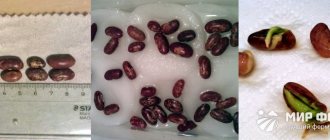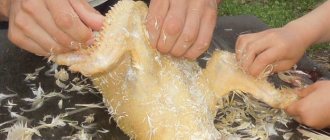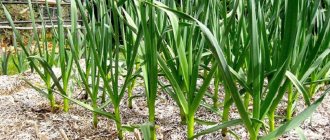Every secondary school student sooner or later receives the task of conducting an experiment and learning how to germinate beans for further planting in the ground.
This experiment usually does not cause difficulties. Germination of bean seeds is easy to achieve by providing them with moisture, light and air. To germinate beans at home for school as quickly as possible, all you need is available materials and high-quality seeds. You can do this in different ways:
- For the first method,
you will need a flat plate, as well as a piece of cotton fabric or gauze. Pre-selected grains are laid out on a cloth-covered plate and water at room temperature is poured in so that it moistens the flap generously, but does not bleed past its edges. It is advisable to use boiled or settled water, and to be sure of the result, you can add a little growth stimulants. If desired, cover the beans with an additional piece of fabric. By placing the plate in a warm place, the first bores can be detected the very next day. The main thing is not to let the fabric dry out, and especially not to immerse the beans in water. Otherwise, instead of the desired sprouts, you may end up with rotting seeds. - Second way.
Sprouting beans for school, as in the first case, is quite simple. To do this, the selected grains are first placed in warm water for several hours, and then washed and placed in a glass vessel with a volume of approximately 0.5 liters. The container must be covered with cotton cloth, gauze or a ventilated lid and the required humidity must be maintained using a regular spray bottle. Within a few days, the beans will germinate and be ready for planting in the ground.
How to quickly grow beans at home for school?
Germinating bean seeds before directly planting them in the ground speeds up germination and promotes the formation of stronger roots and shoots. The optimal length of sprouts before planting in the ground is 1-1.5 cm. If the sprout is longer, it can easily be accidentally broken off.
Bean seedlings are planted in half-liter plastic cups or flower pots filled with loose soil, adding drops of 1.5 cm. Then place the pot in a sunny place and periodically water it, preventing the soil from drying out. After just a month, the first flowers may appear on the plant.
Beans, along with other legumes, are used to prepare various dishes, including raw salads made from sprouted grains. Gardeners plant it on the plot to get a harvest grown with their own hands. In both cases, the legume crop needs to be sprouted. Below is information on how to properly germinate beans for eating and planting in the garden.
Why are beans sprouted?
Adherents of proper nutrition recommend eating sprouted sprouts of various crops, including beans. They contain a large amount of vitamins and microelements necessary for the body. The food used is small green mung beans called peas. Salads, stews, and cutlets are prepared from it. The procedure for sprouting beans is carried out for several reasons:
- When sprouting, sugars that contribute to bloating are decomposed.
- The amount of healthy protein in grains increases by 30%, the amount of carbohydrates decreases by 15%.
- The carcinogen aflatoxin is deactivated.
- The number of enzymes increases 100 times.
- Eating bean sprouts helps eliminate toxins.
If the legume crop is not used for eating raw, but as planting material, germination will help the seeds germinate quickly. The gardener will be able to harvest the harvest earlier than when planting beans without sprouts.
Sprouting beans for seedlings
To germinate beans for seedlings, gardeners use an old, proven method. As strange as it may sound, you will need toilet paper for this. It is laid out on top of an elongated cellophane roll (up to 50 cm in length), moistened with water, and bean grains are laid out on top of it. When laying out seeds, it is important to make an indent along the edges, preferably if it is at least 1 centimeter. Place another layer of paper on top of the beans, moisten it with water and roll it up. To germinate seeds, it is lowered from the empty edge into a container of water.
How many days will it take for sprouts to appear using this method of germination? Seed germination is observed after a few days, but the sprouts are planted in the beds after about a week and a half, when they are fully strengthened.
Basic methods of germination
Beans are sprouted both for consumption and for planting in open ground. Each option has its own nuances.
How to quickly sprout beans for food
There are several ways to germinate legumes for food. With any of the methods, the grains swell overnight, and after 1-2 days the first seedlings appear. First, the seeds are soaked in water for several hours, then germination will occur faster.
In damp cloth
The beans are laid out on a moistened material and covered with the same layer of cloth. Every 2-3 hours, the legume is moistened with water from a spray bottle. When moistening, you need to make sure that there is no excess liquid on the surface. Because of this, the seeds stop breathing and may become moldy.
In a glass container
Sprouting beans in a glass container at home in stages:
- The washed seeds are placed in a glass jar.
- Cover the container with damp gauze or other cloth.
- Then the dishes with beans are placed in a warm place.
Twice a day - morning and evening, the beans need to be washed, then put back into the jar. When using this method, there is no excess moisture in the dishes, as a result of which heat exchange is not disrupted and the seeds do not become moldy.
On cotton pads
First, cotton pads or balls are placed in the dishes, and beans are placed on them. Everything is moistened with a small amount of water. The container is placed in a warm place. Seedlings appear the next day.
Germination of bean material for planting in the ground
For planting in the ground, several options for soaking seeds are also used. Germination begins after 2 days. The grains begin to germinate a few days before planting in open ground. First, they are washed, soaked for several hours in water, then in a weak solution of potassium permanganate to prevent fungal diseases.
In a rolled-up cigarette
The procedure is performed as follows:
- A roll of toilet paper is spread on the film, which is then sprayed with water from a spray bottle.
- The beans are laid out at a distance of several centimeters from one another.
- A layer of paper is laid on top, which is then moistened.
- The film is rolled up and the bottom edge is dipped into water.
After a few days, the beans are ready for planting.
In the dishes
For germination, use a colander, deep bowl, and gauze. The procedure is performed as follows:
- Gauze is placed inside the colander.
- seed spills out.
- The top of the beans is covered with gauze.
The legume crop is watered from above with water, the excess of which flows through the holes into the bowl. You need to make sure that the gauze on top is wet all the time.
In peat pots
Young seedlings do not tolerate transplantation well, so beans can be planted in peat pots with moist soil. When they grow up, they are planted in open ground along with pots. As peat decomposes, it will serve as additional nutrition for the root system.
School experiences
In a biology lesson, schoolchildren conduct various experiments, one of which is the correct sprouting of beans. To do this, use a nylon lid, cotton pads, and beans from the store. Germination procedure step by step:
- Wet discs are placed in the lid.
- Then the grains are laid out in one layer.
- The beans are covered with cotton pads, which are moistened with water.
You need to ensure that the discs are kept wet at all times, but without stagnating liquid. Within a couple of days, sprouts will appear.
Growing beans after germination
This garden crop loves warmth and does not tolerate low air temperatures. Therefore, it is planted in open ground only after warm weather has finally established itself. This usually occurs in May, depending on the climate and weather conditions.
For planting, choose an open area where the plants will have enough sunlight. The soil in the chosen location should be light and loose, without close proximity to groundwater. Before planting the plants, the soil is loosened.
Selecting a bean variety for your home
Beans come in climbing and bush varieties. Each type is divided into asparagus, shelling and decorative. The choice of a specific variety is influenced by the characteristics of the climatic zone and the place where the plant will be located.
Hulling varieties are also called grain varieties. They use only the grains themselves for food. The pod valves of these varieties are too hard to eat. These varieties love warmth and ripen for a very long time. For this reason, they are grown only in the southern regions.
Green bean pods do not contain any hard fibers. Therefore, they can be eaten. Fruiting of these varieties begins two months after germination. At the same time, the crop ripens gradually. It is collected in batches before the cold weather arrives.
Ornamental varieties are needed to improve the quality of the soil and decorate the garden. These beans enrich the soil with nitrogen, which is extracted by plants from the air. This element is necessary for the rapid growth of Solanaceae and other plants.
On a note!
If you plant beans nearby, the plants will suffer less from late blight.
Bush varieties can be grown as indoor plants. Their root system does not exceed 20 cm in length, and the height of the shoots is up to 50 cm. Therefore, the plants do not take up much space and fit in a standard flower pot. There is no need to tie them up and build a support for the lashes. In addition, such beans ripen very quickly.
Climbing varieties are usually used for growing in open ground. They have a long root system and developed vines. These beans bear fruit abundantly. It is often used to decorate gazebos, arches and other decorative structures.
How to plant beans in a pot
For seedlings, grains are planted in small containers filled with a nutritious soil mixture consisting of peat and humus. A depression is made in the center of the container and the dry or sprouted grain is placed in it to a depth of 3-4 cm. The prepared pots with seeds are placed on a lighted windowsill, where the temperature exceeds +20 degrees. After 2-3 weeks, the seedlings will have grown enough to be transplanted into an open area.
Planting in open ground and caring for it
After preparing the site, holes are made in the garden bed and the prepared sprouts are placed in them to a depth of 5 cm. Bush varieties are planted at a distance of 15 cm; for others, the optimal interval is 10 cm. Compost is placed at the bottom of the planting hole to provide the plant with useful substances.
Before planting sprouted seeds, the bed is watered with warm water. The beans are placed horizontally, covered with soil and watered with a small amount of water.
Caring for plants involves regular irrigation, clearing weeds and loosening the soil. This crop needs air to reach the roots. Therefore, between waterings, the soil must be loosened to a shallow depth so as not to disturb the root system of the plant. Watering should be moderate; too much watering causes rotting of the root system. If there is not enough moisture, the ovaries and flowers fall off.
Harvesting
When to pick ripe beans, they decide based on their variety. Asparagus varieties are picked twice a week. Less frequent harvesting causes the fruit to become overripe. Ripe pods are cut with scissors to avoid damaging the stem.
The peeling varieties are picked after full ripening. The green ones are left on the plant to ripen. The degree of maturity of the pod is determined by breaking it. When scrapped, the edges of the halves will be smooth, without traces of fibers.
Important!
Immediately after removal, the beans are removed from the pod. They cannot be stored unpeeled for a long time. The shell accumulates moisture and the grains may become moldy.
Before being sent for storage, the beans are dried in the sun. For storage, the collected beans are placed in linen bags or placed in sealed jars.
Bean care
As soon as the beans sprout, the bed is watered with water, then the soil is loosened. The procedure is carried out carefully so as not to damage the fragile seedlings. Subsequently, loosening is combined with weeding. Water the beans so that the soil is moist but not wet. Moisture is especially needed during the formation of pods. 25-30 days after seed germination, young plants are fed with complex mineral fertilizer. The next feeding is after 20 days.
To prevent plantings from being affected by fungal diseases, it is necessary to observe crop rotation, disinfect seeds, and burn infected bushes.
Pests in the form of snails and slugs are collected by hand. Climbing varieties of beans need to be tied to supports so that they do not break from the wind.
How to quickly germinate beans
For the speedy emergence of sprouts, it is important not to allow the tissue in which they are located to dry out. Varieties such as mung bean are pre-soaked in water, which significantly speeds up the appearance of sprouts. To get the desired result overnight, growth stimulants are used, which are combined with water. In this case, the first shoots will be ready for planting the very next day.
The easiest way to sprout beans for eating is to place the beans in a damp cloth. As a rule, after one or two days the sprouts are ready to eat.
Planting germinated material in the ground
The seeds should not be allowed to outgrow, otherwise the roots will begin to intertwine with each other. When separated, fragile seedlings may break, which will affect the germination of grains. Beans are planted in the second half of spring. By this time the earth is warming up, and the threat of return frosts has passed. This is important because the legume crop is not frost-resistant; even minor frosts can destroy it. The place for planting beans is chosen to be well-lit, with loose, breathable soil. The grains are planted sideways in the ground so as not to damage the roots.
Holes are dug 5-6 centimeters deep, watered, seeds are placed in them, and covered with earth. The distance between plantings is 20-30 centimeters. If the grains are planted in dry soil, there is no need to germinate them.
Additional Information. According to popular wisdom, beans can be planted after the chestnuts begin to bloom.
Sprouting beans for planting in the ground
The technology for germinating beans for planting is not much different from the previous method. Before the procedure, it is still necessary to sort out spoiled seeds and remove excess debris. Next, a plate of medium depth is shaved, and a damp cloth or gauze is placed on it. Selected grains are laid out on top of the material soaked in warm water and covered with a top layer.
It is important that the fabric is just damp. Water should not leak out of it, otherwise it will cause the beans to rot.
Germination time usually takes 1 day. The very next day, fragile sprouts will appear and are planted in the soil. This is done very carefully, the distance between the rows should not be less than 50 cm, between the seeds - at least 20 cm.
See also
Technology for growing and caring for beans at the dacha in the open groundRead
Use of bean sprouts
The main use of bean sprouts is cooking. First courses, side dishes, snacks are prepared from this product, and sometimes added to baked goods. In folk medicine, bean sprouts are used to prepare remedies for treatment.
Bean sprouts help improve health in the following diseases:
- atherosclerosis;
- diabetes;
- high blood pressure;
- excess weight;
- insufficient immunity;
- diseases of the digestive system.
Bean feeding
In the apartment, manure or droppings will cause an unpleasant odor. Humus added to the soil before planting will be enough to avoid using organic matter for a long time. During bud formation, organic supplements are contraindicated. Plants need trace elements and potassium. All these necessary components are contained in the ash; it is poured onto the surface of the earth, loosened carefully and the bushes are watered.
Stores sell natural fertilizer - horse manure extract. The drug is odorless, beans respond well to such fertilizing.
School project
Legumes are grown very easily and quickly, so they are often recommended to students for experimentation. The purpose of such research work is to find out what conditions are necessary for the growth and good development of a bean or pea seed.
Beans are germinated in only 4 stages:
- Place a layer of “soil” in any clean container: saucer, bowl, plate, plastic container, nylon lid. Cotton wool, bandage, gauze, cotton pads or even synthetic padding are suitable as a primer.
- Moisten the “soil” generously with water, creating the moist environment that the beans need.
- Create greenhouse conditions. Cover the container with the contents with a piece of cling film or cellophane, so that the film does not touch the beans and is stretched over it. Secure with a regular rubber band or thread. Make several small holes in the film for air circulation.
- Place an improvised “greenhouse” in a dark, warm place and monitor the amount of water in the “soil”.
After a week, the sprouts can be planted in the ground and beans can be grown at home on the windowsill while continuing to monitor their development.
In any school project, students are given more detailed instructions and they should adhere to them in their project.
Sprouting beans at home is very simple and interesting. As a school project, it will help develop accuracy and attentiveness without extra effort, and as a dietary supplement it will help improve the condition of the skin and hair, eyes and gastrointestinal tract. Bean sprouts are not only rich in vitamins and minerals, but also contain all substances in a form that is easily absorbed by the body.
Many gardeners germinate their seeds before planting beans. This procedure speeds up the emergence and ripening of the crop. Bean sprouts are used as food by adherents of a healthy diet. Sprouts are rich in protein and are a living source of vitamins. Depending on the purpose of further use, different methods are used to germinate bean seeds. Knowing the basic rules of germination, you can quickly get strong sprouts and grow hardy plants from them.
Care and watering
Beans at home need to be properly cared for. The legume family is moisture-loving plants. Water the bushes generously until the first pods appear. Water is poured at the root; moisture should not get on the foliage to avoid fungal infection.
Water the plants in the morning or evening. Watering is stopped after the first 2-3 leaves appear. They begin to moisten the soil during flowering. Water 2 times a week.
You may be interested in:
How to quickly get rid of bugs in beans Beans are a tasty and healthy vegetable, which in terms of protein content is equivalent to meat. Bean dishes are nutritious and high in calories,...Read more...
As the plants grow, a stick is stuck into the ground. Curly stems are tied to it. The support prevents branches from breaking off.
Adult bushes require 12 hours of daylight, and young plants need 14-16 hours. During this time, flower buds have time to form. In winter and on cloudy days, additional lighting is connected.
Why can't bean seeds be sprouted in soil?
You cannot germinate seeds that are used for food in the soil. In addition, beans sown in a box for seedlings will not tolerate transplantation well. For this reason, if a gardener wants to get an early harvest, the seeds need to be planted in peat pots, which are then planted in open ground. In the southern regions, they often practice planting without soaking, planting beans with the onset of heat in the grooves, which in this case do not need to be moistened.
- View the full image
Proper germination of beans is the basis for obtaining quick, friendly shoots and a good harvest. Gardeners who plan to grow beans at their summer cottage in open ground need to know the basic rules, and those who want to use sprouted sprouts for food as a living source of vitamins. Knowing how to quickly germinate beans, you can get strong sprouts in a few days, which over time will turn into strong, hardy plants.
Preparing beans for sprouting
Before soaking, the seeds are sorted, rejecting substandard ones. Blackened, beetle-eaten dry beans are removed. Such seeds will still not be able to germinate, but will only take up space in the dishes. The beans are then thoroughly washed, especially if they are being sprouted for consumption. For 4-5 hours it is placed in a bowl with water to swell, then germinated using one of the selected methods.
Advice! In order for the beans to germinate faster, they need to be kept in water for 4-5 hours to swell.
The benefits of sprouts and how to add them to the menu
Sprouted beans have high nutritional value; they are eaten as an independent dish, used to make salads or as a component of more complex treats. In their raw form, beans go well with fresh herbs, berries and fruits. Bean sprouts are also a main ingredient in many Asian recipes, be it Chinese, Indian or Korean. They are even used for baking.
The most useful combination is considered to be sprouted beans and oat sprouts. They complement each other perfectly and provide the body with a large supply of nutrients, minerals and vitamins.
Important Despite all the undeniable benefits, it is necessary to introduce bean sprouts into the diet gradually, as there is a possibility of intolerance.
When using for the first time, you need to be careful and not get carried away with a large number of sprouts. First they are tasted, for example, in the form of a sauce, then as an ingredient in a salad. After each test, you need to observe the body's reaction.
If an allergic reaction occurs, sprouted beans should be discarded. If no unpleasant reactions occur, then the portion of sprouts is gradually increased, but you should not abuse it, 100-150 grams per day is enough (this is about 2 tbsp. L).
Description of beans
Beans contain a large number of nutritional components for humans: vitamins, proteins, minerals, fats, fiber, amino acids, carbohydrates. Beans are divided into 3 types: climbing, semi-climbing, and bush. In climbing legumes, the stem length can reach 4-5 m, semi-climbing plants stretch up to 1-1.5 m. The bushes grow 30-70 cm in height.
The bean blooms beautifully, and is often grown to decorate a summer cottage; it entwines fences, arches, and columns, creating colorful compositions. The beans have large, bright green leaves and moth-shaped flowers of different shades. Flower colors are white, red, black, purple. Inflorescences consist of 2-6 racemes. The size of the pods depends on the chosen variety, length from 5 to 25 cm.
You may be interested in:
Bean variety “Black Eye”: description and characteristics A bean variety called Read more…
The beans are divided:
- grain - only the fruits are suitable for eating, the pods are not suitable for food;
- vegetable (asparagus) - the entire pod is edible, the pods are soft, sweet, and eaten raw;
- semi-sugar - the pods are consumed when they are not ripe, the ripe leaves are hard;
Beans love warm and well-lit places. Beans germinate at temperatures above 10 degrees. According to the ripening period, legumes are early-ripening, mid-ripening and late-ripening. To grow beans on a windowsill, beans with early ripening periods are mainly used.
Interesting!
Green beans have a low calorie content - 41 kcal per 100 g.
How to increase seed germination
It also happens that testing shows good germination. You sowed them in a bowl for seedlings, but they just don’t sprout. What to do?
There is a very simple way to prepare seeds - to “force” the seedlings to emerge from the ground faster. True, it is more suitable for a small amount of seed. Place your bowl with the sown seeds inside a plastic bag and breathe into it. Then quickly tie the bag and place it in the same place. The carbon dioxide you exhale and its concentration inside the bag will have a beneficial effect on the seedlings. Soon you will see the first shoots.
Germination can be increased by heating. To do this, place the seeds in a thermos with water at a temperature of 40-50°C. Keep them there for at least 6 hours.
This method is contraindicated for tomato seeds!
It is better to subject them to a hardening procedure. Rinse the seeds calibrated in salt water. It is advisable to disinfect them with a solution of manganese or colloidal silver. After all this, place the bowl with the seeds in a plastic bag and put it in the refrigerator where you store the vegetables for 10-12 hours. Repeat this procedure every day for a week. That is, the seeds are at room temperature for 12 hours. And the remaining 12 hours - in the refrigerator.
- home
- List of sections
- The world
- Growing beans
Preparing bean seeds
Preparing bean seeds for germination is quite simple. First of all, you need to carefully sort the seed, removing all wrinkled, dried or moldy grains, as well as removing various debris. After this, you can use one of the germination methods and get strong sprouts in just a few days.
You need to know that not all types of beans are suitable for eating in their raw, unprocessed form. Fans of raw food and healthy eating prefer to sprout Mung beans and Mung beans.
Young sprouts are a real storehouse of vitamins that help improve digestion and strengthen the immune system.
However, red beans should not be consumed raw. It contains toxic proteins lectins, which can lead to severe poisoning. During heat treatment they are destroyed, so it becomes completely safe.
How to grow for food
At home, you can quickly germinate beans for food in several stages:
- Carefully select and rinse the legumes under cold running water.
- Take a deep plate and a sieve that will fit on this plate. This design will help preserve the taste of the sprouts: excess moisture negatively affects it.
- Line the bottom of the sieve with a thick layer of gauze and pour in the beans.
- Saturate the gauze layer with enough water so that the water above it rises 5 mm.
- After 12 hours, rinse the beans and get rid of excess water.
- Place the container with the contents in a warm, dark place and spray every 3 hours.











